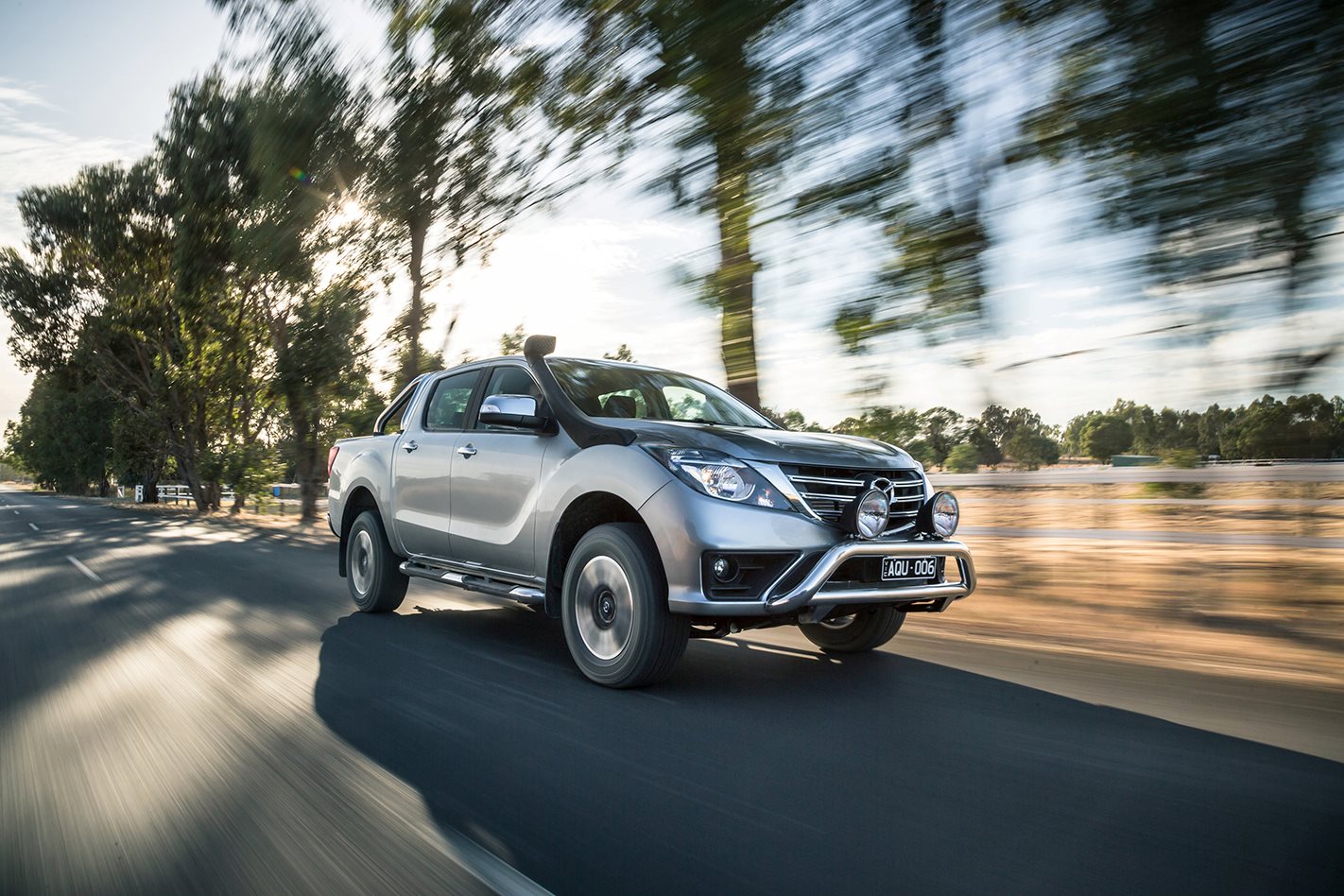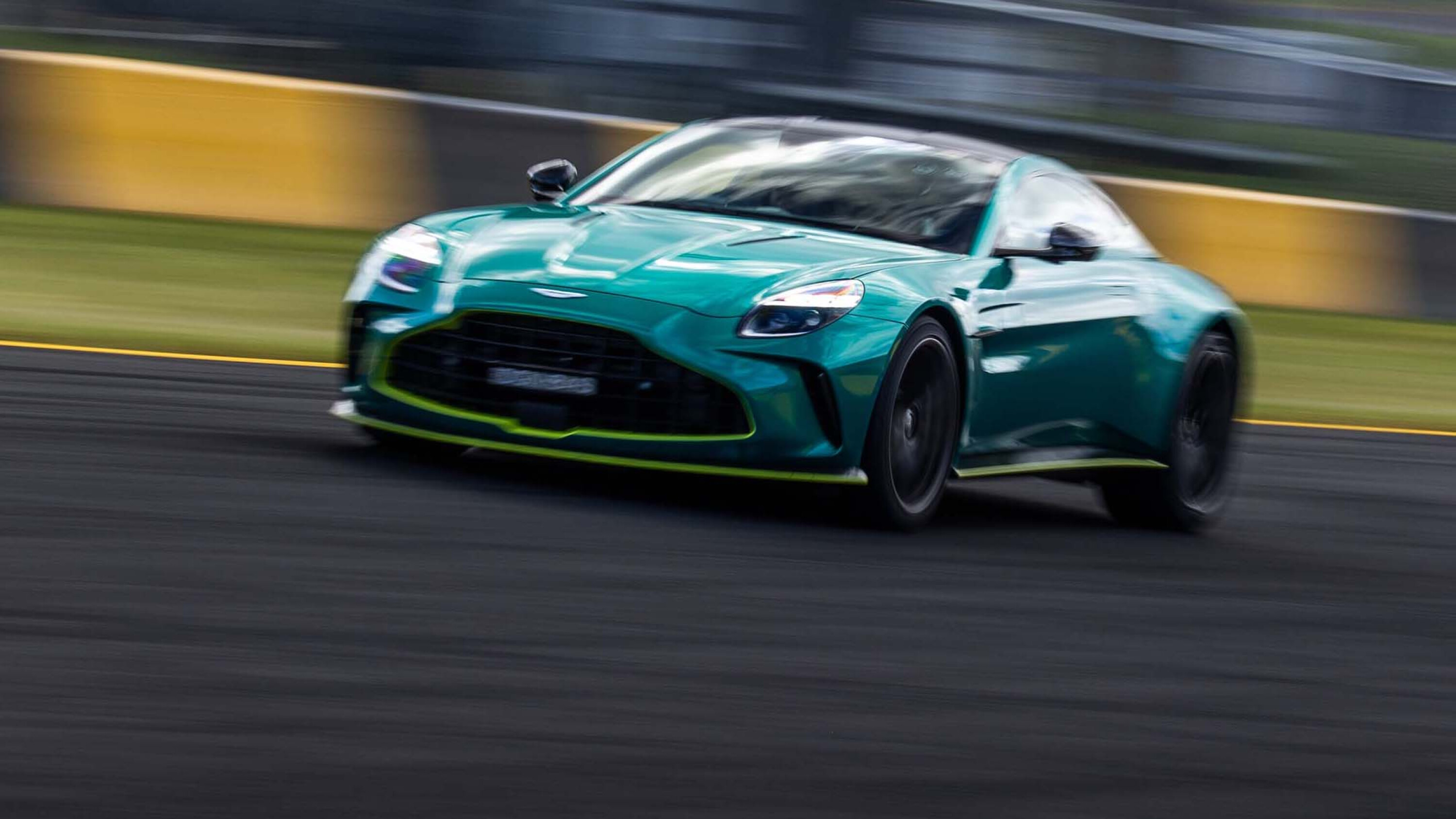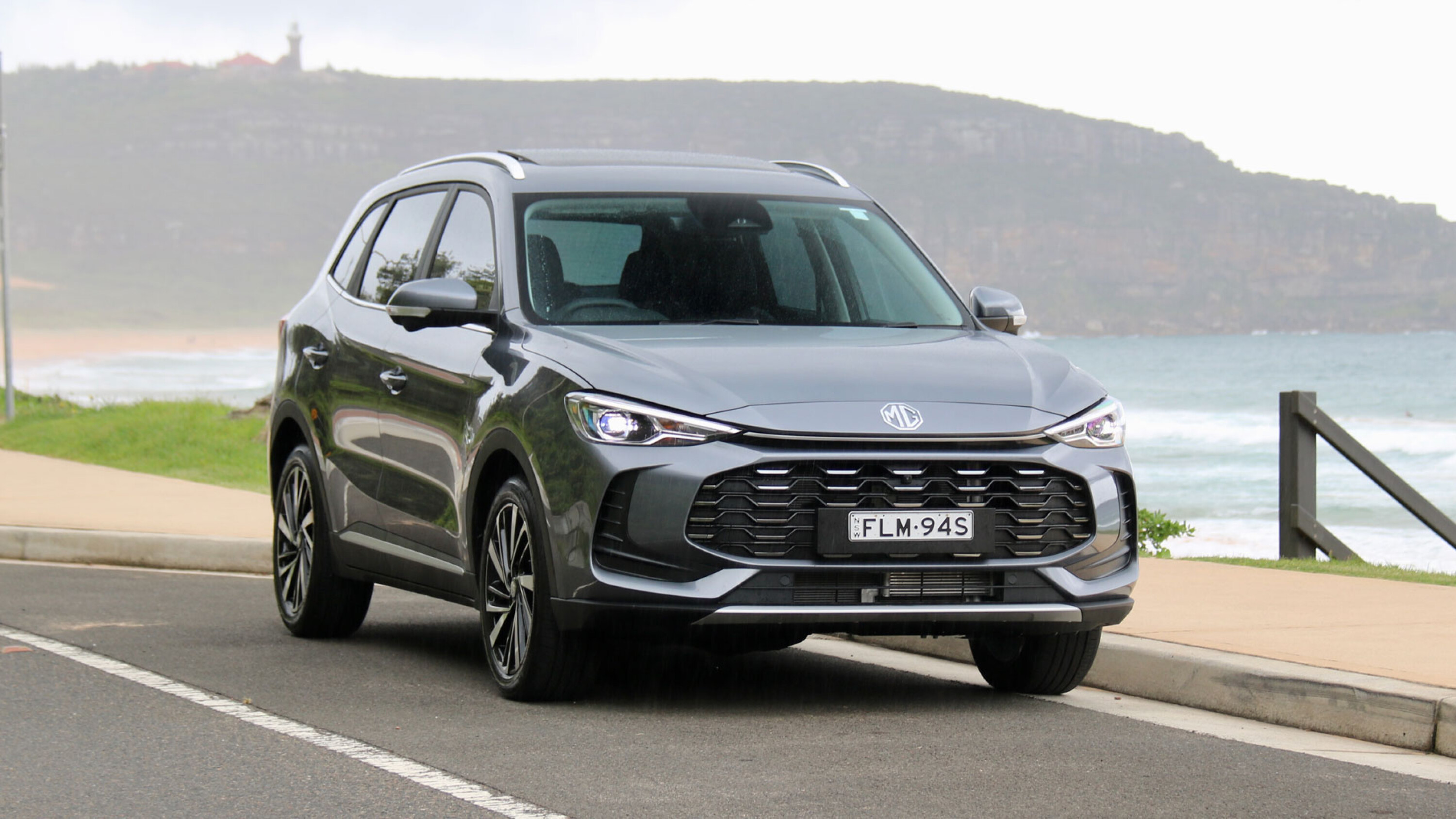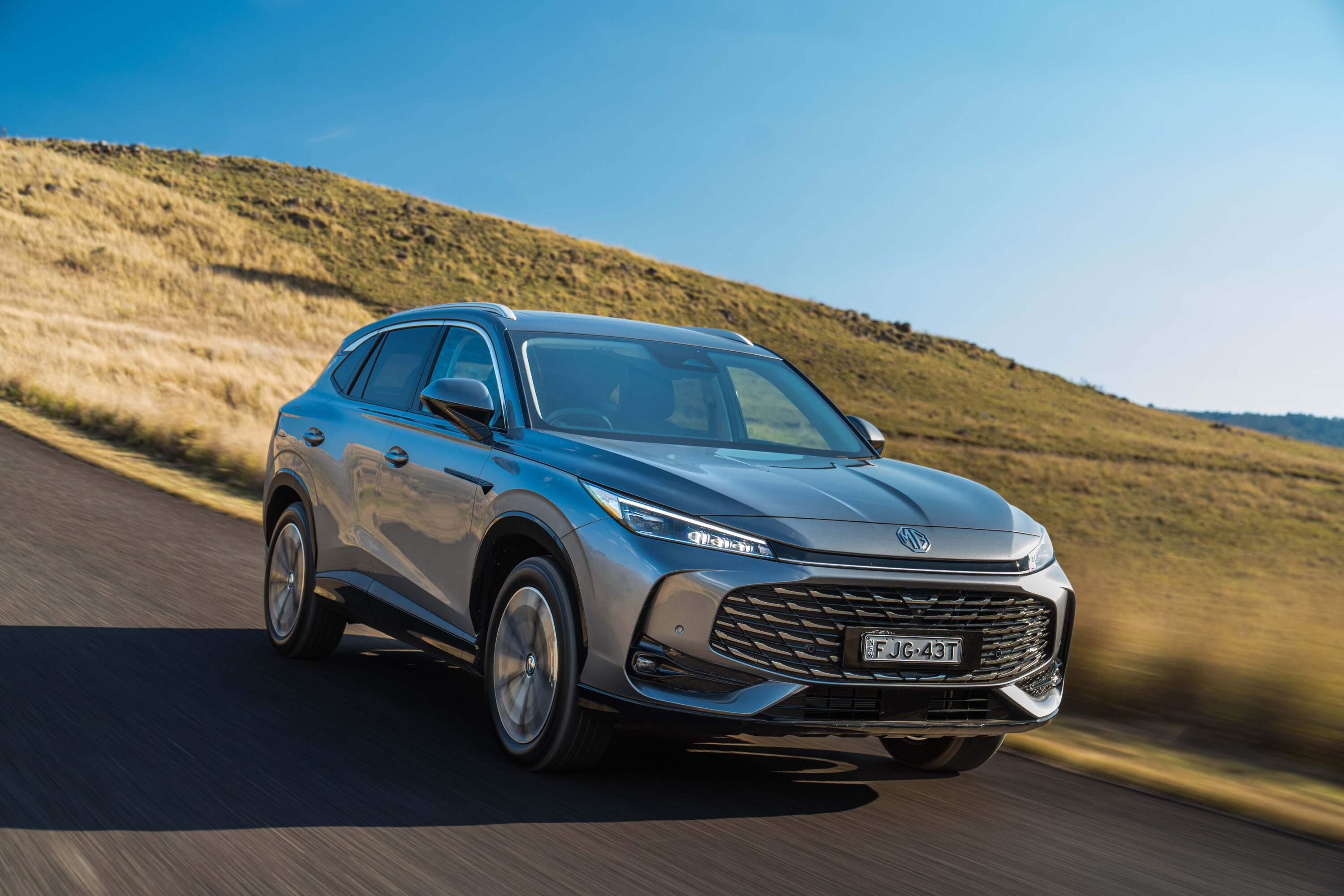
Score breakdown
Things we like
- One of the better multi-purpose utes, latest infotainment
Not so much
- Weighty low-speed steering
- Firm ride
What stands out?
The Mazdas BT-50 offers one of the stronger engines in the ute market, a 3.2 litre, five-cylinder turbo-diesel that is quite fuel-efficient. Stability control is standard, as are head-protecting side-curtain airbags for rear passengers. You can get rear-wheel drive and four-wheel drive versions, ranging from farm trucks to family-friendly dual-cab utes. The current model features an updated front bumper design that’s unique to the Aussie market, and is the first Mazda to feature Apple CarPlay and Android Auto connectivity.
What might bug me?
The bumpy ride when the tray is empty. It’s a feature of all utes like this, because they need stiff rear springs to support the one-tonne loads they can carry.
What body styles are there?
Single Cab, Freestyle Cab and Dual Cab, and in both cab-chassis and ute form.Buyers of cab-chassis models fit trays of their choice at the rear, commonly tailor-made by aftermarket specialists. Only Freestyle Cabs and Dual Cabs come as utes, with a factory-fitted tub at the back.Dual Cabs have a conventional four-door arrangement, with seating for five. Freestyle Cab models have fold-down seats behind the front seats, accessed via small rear-hinged doors.The BT-50 is available as a rear-wheel drive vehicle, or with dual-range four-wheel drive.Every rear-wheel drive BT-50 but one is a Hi Rider model, with high ground clearance like the 4WD models. The exception is the 2.2 XT Single Cab chassis 4×2 manual.The 4WD system in BT-50s is part-time, which means you must select rear-wheel drive for sealed roads but may switch to 4WD on loose surfaces. Dual-range gearing gives you a second set of gears, with low ratios that let you drive comfortably at very slow speeds when tackling difficult terrain off road.The BT-50 is classified as a light commercial pick-up.
What features do all Mazda BT-50s have?
Cruise control, and a multi-function trip computer.Infotainment system with central touchscreen, radio, Bluetooth phone connectivity and audio streaming, USB and auxiliary input jacks, and at least four speakers. Audio controls on the steering wheel, and a 12-volt outlet. (The Alpine-developed multimedia system does not include a CD-player, however.)Apple CarPlay/Android Auto smartphone pairing – the BT-50 was the first Mazda model in Australia with this feature.Reversing camera.Height adjustment for the steering wheel, and height and lumbar adjustment for the driver’s seat (except where a bench front seat is fitted).Trailer-Sway Control, which helps stabilise the ute if a trailer you are towing sways from side to side.Electronic Traction Control, which is a great help in slippery off-road conditions.Hill-Launch Assist, which stops you from rolling backwards when you are trying to move off on an uphill slope.Four (on single cabs) or six airbags. Anti-lock brakes, and electronic stability control – which helps you avoid and control skids. (For the placement of airbags, and more on Mazda BT-50 safety features, please open the Safety section below.)All four-wheel drive BT-50s have a driver-activated rear differential lock, to help the car maintain progress in extreme off-road conditions.All BT-50s are covered by Mazda’s three-year, unlimited kilometre warranty.
Which engine uses least fuel, and why wouldn’t I choose it?
The 2.2-litre four-cylinder turbo diesel is the more economical of the two engines on offer but only when coupled to the manual gearbox, where it uses a thrifty 7.6 litres/100km in the official government combined-cycle test and is also very economical in the real world.Unfortunately this engine is available in only two models, both basic work trucks with single cabs and two-wheel drive.The alternative engine is the considerably more powerful 3.2-litre five-cylinder turbo diesel, which comes with every other BT-50 and is available with either a six-speed manual or a six-speed automatic gearbox.In the official test the 3.2 uses between 8.4 and 9.2 litres/100km, depending on the variant. In real-world driving, expect a BT-50 with the 3.2 engine to use about 12 litres/100km.(Power outputs and all other Mazda BT-50 specifications are available from the Cars Covered menu, under the main image on this page.)
What key features do I get if I spend more?
Prices start with the 2WD 2.2-litre XT Single-Cab chassis, a basic work truck with 16-inch steel wheels, cloth seats, and a vinyl floor.By spending more money you can get the more powerful (3.2-litre) engine, four-wheel drive, a cab with rear seats, a ute-style cargo area, and extra equipment.Pay for a dual-cab XT Ute and you also get fancier wheels, made from lighter (but arguably less robust) aluminium alloy. A reversing camera is available on XT models as an extra-cost option.Choose a BT-50 XTR and you get a slightly bigger 8.0-inch central screen with USB, Aux and HDMI inputs (so that you can watch videos on the screen from external sources). There is satellite navigation, and it can show off-road maps that render the terrain in 3D. Digital radio reception is available, there are six speakers, and Bluetooth-connected phones can be operated by voice.An XTR also has carpet on the floor, and dual-zone air-conditioning (which allows the driver and front-seat passenger to set their preferred temperatures). Windscreen wipers operate automatically when it rains, and the headlamps switch on automatically when it gets dark. You get front foglights, and side-steps. And the alloy wheels are an inch bigger in diameter, at 17 inches.The most expensive BT-50 is the GT, which is available only as a 4WD Dual Cab Ute. In addition to the XTR features, it has leather trim, power adjustment for the driver’s seat, heated external mirrors, chrome sports bar with integrated LED stop-light, 12v socket in the tub to run accessories, a heavy duty tub liner, tailgate central locking, and tinted windows.
Does any upgrade have a down side?
Going from a Single Cab to either a Freestyle or Dual Cab reduces both the tray length and the weight you can carry. The more expensive, better equipped versions also carry less.White paint is available at no extra cost. All other metallic and mica paints cost more.
How comfortable is the BT50?
The BT-50 has a roomy and comfortable cabin, although the quality of the fit and finish falls short of the high standard set by Mazda’s passenger cars. XTR and GT models have a good-sized display screen in the centre of the dash, along with a multimedia system developed by Alpine Electronics.The GT model brings a sense of luxury with its leather seats, and powered seat adjustment for the driver.On the road the BT-50 has the somewhat stiff-riding feel of a ute but it still rides and handles better than most other utes. It’s on par with the Ford Ranger, but not as good as the Volkswagen Amarok.
What about safety in a BT-50?
All BT-50s have anti-lock brakes, stability control, and good airbag coverage.Single Cab BT-50s have four airbags: two to protect the driver and front-seat passenger in frontal impacts, and two curtain airbags to protect their heads in side impacts.All Freestyle Cab and Dual Cab BT-50s also have side airbags that protect front occupants at chest level from side impacts, and full-length side-curtain airbags that protect front and rear passengers at head level – making six airbags in total.A reversing camera is standard on XTR and GT BT-50s, and an expensive option on XTs.The Australasian New Car Assessment Program has rated the BT-50 at five stars for safety, its maximum, most recently in December 2011.
I like driving – will I enjoy this car?
Utes aren’t designed to be driver’s cars. That said, the BT-50 one of the better utes to drive, with precise steering and surprisingly good handing. Like most utes, it is better with some weight in the rear tray or tub, to help settle the rear springs.The 2.2-litre engine is smooth and willing. The 3.2-litre engine is a bit gruff and noisy but has much more power – indeed it is among the stronger engines available in a 4WD ute. The 3.2 works well with the smooth-shifting automatic gearbox. However, the manual gearbox was much improved in the mid-life model update of October 2015, and is also an excellent choice.The BT-50 is very much like the Ford Ranger to drive, as it’s very close to being mechanically identical to the Ranger. One key difference is in the steering assistance, which unlike the Ranger’s is not variable (the Ranger’s electric system offers extra assistance at low speeds, which makes parking easier). At highway speeds, however, the BT-50 steers every bit as well as the Ranger, and arguably better.The other main difference is in the ride from the suspension: the BT-50 does not feel quite as comfortable as the Ranger (because the damping is firmer). When co-developing these two utes, Ford and Mazda went their own ways when fine-tuning the chassis, and Ford did a better job of tailoring the suspension for Australian conditions.
How is life in the rear seats?
Dual-Cab BT-50s have a roomy and comfortable rear seat. It’s a match for the rear seat in most medium SUVs, but – as in most utes – the backrest is more upright.The two small folding seats in the rear Freestyle Cab models are suitable only for children and small adults, and only over short distances. You can get into the seats easily through the small rear-hinged doors, which can be opened only after the front doors have been opened.Freestyle and dual cabs have two child restraint anchors.
How is it for carrying stuff?
Excellent, of course. It’s a ute! And the BT-50 is also very good at towing.How much you can carry depends on which BT-50 you get. Fewer seats in the cab means more length in the tray, and more weight you can carry (because there’s less weight in the cab).Legally, a BT-50 generally can carry more than most other utes but not a lot more. Even the BT-50 with the least capacity – the GT dual cab – can carry 800kg in the tray (40 bags of cement) and a driver and passenger, and still have 100kg of its rated payload unused.In practice it all works, too. Pack a BT-50 tray with 800kg of cargo and it handles the load quite easily. Its robust chassis feels stable with that sort of load, and there is strong performance from the five-cylinder diesel – even if the engine is a bit noisy.Most BT-50s, even those with the smaller four-cylinder diesel, are legally rated to tow a braked trailer weighing 3500kg – as much as any ute. That’s like towing a robust 20-foot tandem-axle off-road caravan, or a fully loaded three-horse float.In practice, a BT-50 with the five-cylinder diesel engine hauls a trailer that big comfortably, and is stable on the road.A BT-50 fitted with the smaller, four-cylinder, diesel will work very hard to pull that much but it’s still stable handling-wise.The only exception to the BT-50’s 3500kg towing limit is the two-wheel-drive (non-Hi-Rider) single cab, which is rated to tow 2500kg.In any ute, extreme care should be taken when carrying or towing big loads.
Where is the Mazda BT-50 made?
All Australian delivered BT-50s are made in Thailand.
What might I miss that similar cars have?
More power, for more urgent overtaking and easier towing. While the BT-50 is one of the better performing utes, the Volkswagen Amarok V6 feels much more responsive.Active cruise control, which will slow you automatically to follow a vehicle in front, resuming your set speed when the way is clear. This is available on the Ford Ranger, for example.Active safety features such as a forward collision warning (which sounds when you are closing too fast on another vehicle or object), or a lane-departure warning (which alerts you if you begin to drift out of your lane without indicating, perhaps because you are falling asleep). The Ranger and the Holden Colorado offer these, for example.Other utes you might consider include the Mercedes-Benz X-Class, Mitsubishi Triton, Toyota HiLux, Nissan Navara, and Isuzu D-Max.
I like this car, but I can’t choose which version. Can you help?
The 3.2 XTR Dual-Cab Ute 4×4 with the automatic gearbox is the best choice as a family car.
Are there plans to update the BT-50 soon?
This BT-50 arrived in Australia in late 2011. In October 2015 it received a mid-generation update that brought a re-styled nose, and on XTR and GT versions a reversing camera and bigger central screen. BT-50 XTs got a height-adjustable driver’s seat, with the reversing camera an extra-cost option.BT-50 XT-Rs and GTs built from June 2017 came with a touchscreen that was slightly bigger again (at 8.0 inches), with more versatile connectivity and better navigation.The BT-50 received its most significant update in April 2018, which brought a new front-end design specially designed for the Australian market. The update also saw the lower-spec XT versions gain a 7.0-inch touchscreen and reversing camera, and Apple CarPlay/Android Auto was rolled out across the range.Mazda has announced it will develop a new ute in partnership with Isuzu. It is expected about 2020.
Score breakdown
Things we like
- One of the better multi-purpose utes, latest infotainment
Not so much
- Weighty low-speed steering
- Firm ride



